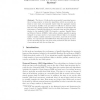Free Online Productivity Tools
i2Speak
i2Symbol
i2OCR
iTex2Img
iWeb2Print
iWeb2Shot
i2Type
iPdf2Split
iPdf2Merge
i2Bopomofo
i2Arabic
i2Style
i2Image
i2PDF
iLatex2Rtf
Sci2ools
HIPC
2007
Springer
2007
Springer
Experiments with a Parallel External Memory System
Abstract. The theory of bulk-synchronous parallel computing has produced a large number of attractive algorithms, which are provably optimal in some sense, but typically require that the aggregate random access memory (RAM) of the processors be sufficient to hold the entire data set of the parallel problem instance. In this work we investigate the performance of parallel algorithms for extremely large problem instances relative to the available RAM. We describe a system, Parallel External Memory System (PEMS), which allows existing parallel programs designed for a large number of processors without disks to be adapted easily to smaller, realistic numbers of processors, each with its own disk system. Our experiments with PEMS show that this approach is practical and promising and the run times scale predictable with the number of processors and with the problem size.
Bulk-synchronous Parallel Computing | Distributed And Parallel Computing | HIPC 2007 | Large Number | Parallel Problem Instance |
Related Content
| Added | 07 Jun 2010 |
| Updated | 07 Jun 2010 |
| Type | Conference |
| Year | 2007 |
| Where | HIPC |
| Authors | Mohammad R. Nikseresht, David A. Hutchinson, Anil Maheshwari |
Comments (0)

